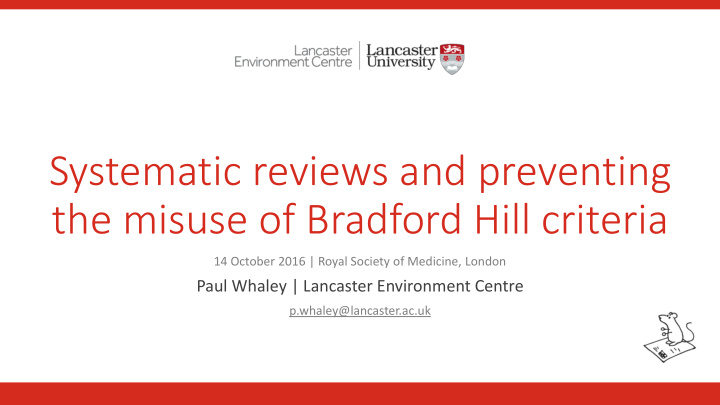



Systematic reviews and preventing the misuse of Bradford Hill criteria 14 October 2016 | Royal Society of Medicine, London Paul Whaley | Lancaster Environment Centre p.whaley@lancaster.ac.uk
About me • Background in environmental health advocacy and science communication • Introduced to systematic reviews as gold-standard approach to evidence synthesis in early 2010 • Advocating use of SR methods to advance validity of results of chemical risk assessments • Associate Editor for Systematic Reviews at Environment International (submissions please!) • Research into quality assurance and control in conduct and publication of evidence syntheses: how do we ensure only high quality reviews get published?
Bradford Hill “use and misuse” • How do we ensure that, when people are evaluating the strength of a body of evidence, they are doing so appropriately?
What I want when I read evidence syntheses • As reader, I want to know: » Has everything been considered which ought to have been? » Has it been considered properly? • To ensure that it’s the evidence, not the reviewer, which is causative in the outcome of the review » Like a lab experiment: it should be the change in conditions between intervention and control groups which causes the change in outcome • BH gives us a list of stuff which we ought to be considering, and guidance on how to consider it • But on its own, it’s not a process: sports equipment without a rulebook
Don’t want naïve processes • For example, BH checklist and the Newcastle-Ottawa Scale (NOS) for assessing the quality of nonrandomised studies in meta-analyses • Shown empirically that scores and scales don’t work (1) » Results contingent on choice of scale, not evidence reviewed • Shown theoretically that they don’t work (2) » Effect of error should be contingent on study context, not choice of scale • Plus, arbitrarily simple and can conceal important information (3) (1) Juni et al. 1999, BMJ (2) Greenland & O’Rourke 2001, Biostatistics (3) Higgins et al. 2011, BMJ
NG, OHAT, SYRINA: non-naïve processes • NG, OHAT, GRADE and SYRINA are not checklists but processes for systematically accounting for important features of a body of evidence, and consistently interpreting those features into a description of how compelling that evidence is
GRADE Working Group, BMJ 2004
Level of confidence in the evidence High Mod Low v Low Initial Study Inconsistency Indirectness Reporting Imprecision judgement limitations of results of evidence bias
SYRINA Strength of evidence: ED activity Vandenberg et al. 2016, Env Health Strength of evidence: health outcome
Algorithms are scientific • To an extent it is algorithmic, but it is not like a checklist or NOS, because the input determines the output, not the process itself. • It is transparent: if the process is producing duff results, (a) this is scrutable, (b) the process can be critiqued and adjusted
Can’t opt out of process • There is always a process • If you use the BH considerations and come to a conclusion, you have followed a reasoning process, you have just kept it secret » What did you put most weight on? Why? » How much did it affect your conclusions? » Would I or anyone else come to the same conclusions? • Secret methods have no place in science: cannot audit them or improve them, and therefore cannot determine whether criteria are being used or misused • If you reject “algorithms”, yet want to police the misuse of BH, then you are rejecting the very thing that will help you
Recommend
More recommend